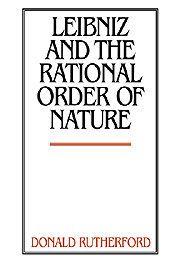Book contents
- Frontmatter
- Contents
- Acknowledgments
- A Note on Citations and Translations
- Abbreviations
- Introduction
- Part I Theodicy
- Part II First Philosophy
- Part III Nature
- 7 Modeling the Best of All Possible Worlds
- 8 Monads, Matter, and Organisms
- 9 Dynamics and the Reality of Matter
- 10 Corporeal Substance and the Union of Soul and Body
- Conclusion
- Bibliography
- Index
9 - Dynamics and the Reality of Matter
Published online by Cambridge University Press: 05 June 2012
- Frontmatter
- Contents
- Acknowledgments
- A Note on Citations and Translations
- Abbreviations
- Introduction
- Part I Theodicy
- Part II First Philosophy
- Part III Nature
- 7 Modeling the Best of All Possible Worlds
- 8 Monads, Matter, and Organisms
- 9 Dynamics and the Reality of Matter
- 10 Corporeal Substance and the Union of Soul and Body
- Conclusion
- Bibliography
- Index
Summary
For Leibniz, our sensory experience is a constant source of deception. We are presented with images of bodies – extended, massive, moving things – along with their colors, sounds, flavors, and odors. Yet none of these things is fully real. Leibniz does not maintain that material phenomena are wholly illusory, or that they are in Berkeleian fashion merely ideas in the mind. He instead argues that sensory perceptions, which prima facie depict a world of extended bodies, are more accurately interpreted as representations of the properties of unextended monads. He defends this claim, we have seen, via an analysis of the nature of matter. As he writes in a 1705 letter to the Electress Sophie, “an analysis of the matter which is now found in space leads us demonstratively to substantial unities, to simple, indivisible, enduring substances, and consequently to souls, or principles of life, which can only be immortal and are spread throughout nature” (GP VII 565).
In the preceding chapter, we examined one version of Leibniz's analysis of matter. It begins from the premise that matter is by nature a multitude of things: Whatever is matter is extended, he reasons, and whatever is extended is composed of a multitude of actual parts. Yet since a multitude can only come to be through unities, and since the only true unities are monads, it follows that any material thing must be a multitude of monads.
- Type
- Chapter
- Information
- Leibniz and the Rational Order of Nature , pp. 237 - 264Publisher: Cambridge University PressPrint publication year: 1995



